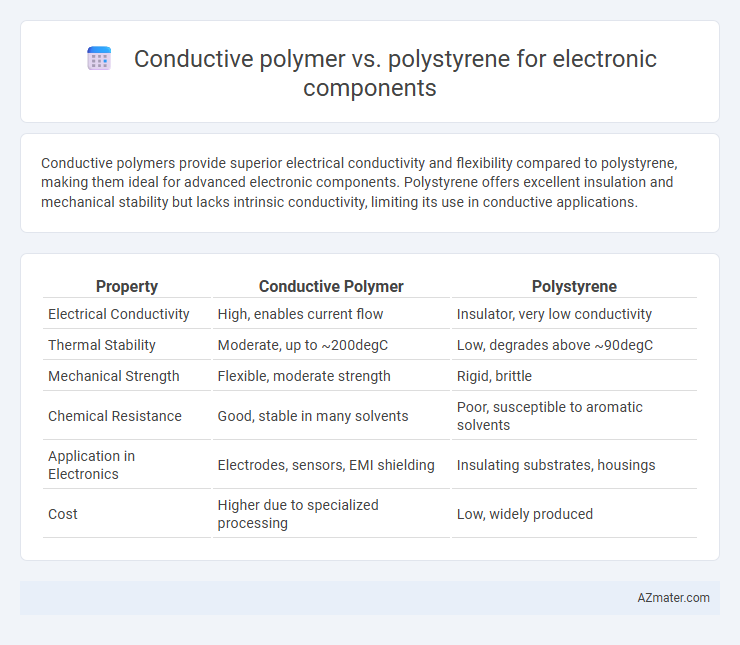Conductive polymers provide superior electrical conductivity and flexibility compared to polystyrene, making them ideal for advanced electronic components. Polystyrene offers excellent insulation and mechanical stability but lacks intrinsic conductivity, limiting its use in conductive applications.
Table of Comparison
| Property | Conductive Polymer | Polystyrene |
|---|---|---|
| Electrical Conductivity | High, enables current flow | Insulator, very low conductivity |
| Thermal Stability | Moderate, up to ~200degC | Low, degrades above ~90degC |
| Mechanical Strength | Flexible, moderate strength | Rigid, brittle |
| Chemical Resistance | Good, stable in many solvents | Poor, susceptible to aromatic solvents |
| Application in Electronics | Electrodes, sensors, EMI shielding | Insulating substrates, housings |
| Cost | Higher due to specialized processing | Low, widely produced |
Introduction to Conductive Polymers and Polystyrene
Conductive polymers, such as polyaniline and polythiophene, exhibit electrical conductivity due to their conjugated backbone structure, enabling their use in flexible electronics and sensors. Polystyrene, a non-conductive thermoplastic polymer, is widely utilized for insulation and structural applications in electronic components due to its excellent dielectric properties and mechanical stability. The contrast between conductive polymers' tunable electrical characteristics and polystyrene's insulating nature highlights their distinct roles in electronic device fabrication.
Material Properties and Structure Comparison
Conductive polymers exhibit intrinsic electrical conductivity due to their conjugated backbone structure, enabling efficient charge transport, whereas polystyrene is an insulating polymer with a non-conjugated aromatic ring structure that lacks free charge carriers. The flexible, amorphous morphology of conductive polymers allows for tunable electrical and mechanical properties, while polystyrene's rigid, glassy structure provides excellent dielectric strength but limits its conductivity and flexibility. Material properties such as conductivity range from 10^-5 to 10^3 S/cm in conductive polymers compared to polystyrene's insulating range of 10^-15 S/cm, making conductive polymers ideal for active electronic components and polystyrene suitable for insulating and supportive roles.
Electrical Conductivity: Key Differences
Conductive polymers exhibit significantly higher electrical conductivity compared to polystyrene due to their conjugated molecular structure that allows electron mobility. Polystyrene, a non-conductive thermoplastic polymer, acts primarily as an insulator in electronic components, exhibiting extremely low electrical conductivity. This key difference makes conductive polymers ideal for applications requiring efficient charge transport, while polystyrene serves as a stable insulating material.
Thermal Stability and Performance in Electronics
Conductive polymers exhibit superior thermal stability compared to polystyrene, maintaining electrical conductivity at elevated temperatures essential for high-performance electronic components. Polystyrene, with lower thermal resistance, tends to degrade and lose insulating properties under thermal stress, limiting its use in advanced electronics. The enhanced thermal stability of conductive polymers ensures reliable performance and longevity in demanding electronic applications.
Processing and Fabrication Methods
Conductive polymers offer versatile processing and fabrication methods such as solution casting, spin coating, and inkjet printing, enabling the creation of flexible and lightweight electronic components. In contrast, polystyrene typically requires traditional molding and extrusion techniques, limiting its application where intricate or flexible structures are needed. Conductive polymers' compatibility with low-temperature processing expands possibilities in printed electronics and wearable devices, whereas polystyrene remains favored for rigid, insulating parts in electronics.
Cost-Effectiveness and Commercial Availability
Conductive polymers offer cost-effective solutions for electronic components due to their lightweight nature and ease of processing, reducing manufacturing expenses compared to traditional materials. Polystyrene, widely available and inexpensive, provides excellent insulation properties but lacks the electrical conductivity required for certain applications. Balancing cost-effectiveness and commercial availability, conductive polymers enable innovative device designs, while polystyrene remains a budget-friendly choice for non-conductive components in electronics.
Environmental Impact and Sustainability
Conductive polymers offer enhanced environmental sustainability compared to polystyrene due to their potential for biodegradability and lower toxicity in electronic components. Polystyrene contributes significantly to electronic waste pollution because it is non-biodegradable and difficult to recycle, posing long-term environmental hazards. Transitioning to conductive polymers reduces reliance on fossil fuels and supports circular economy principles by enabling easier recycling and lower carbon footprints in electronic manufacturing.
Application Suitability for Electronic Components
Conductive polymers exhibit superior electrical conductivity and flexibility, making them ideal for applications such as flexible circuits, sensors, and antistatic coatings in electronic components. Polystyrene, known for its excellent insulating properties and mechanical strength, is more suitable for housing, PCB substrates, and insulation in components requiring rigidity and dielectric performance. The choice between conductive polymer and polystyrene depends on the specific application requirements regarding conductivity, flexibility, and insulation in electronic devices.
Limitations and Challenges of Each Material
Conductive polymers offer flexibility and lightweight properties but face limitations such as lower electrical conductivity and environmental instability compared to traditional materials. Polystyrene provides excellent insulation and dimensional stability yet suffers from brittleness, poor thermal resistance, and limited processability in electronic components. Both materials require careful consideration of their mechanical properties and long-term durability to ensure reliable performance in electronic applications.
Future Trends in Electronic Material Development
Conductive polymers demonstrate significant potential for future electronic material development due to their inherent flexibility, lightweight nature, and tunable electrical conductivity, making them suitable for flexible and wearable electronics. Polystyrene, primarily known for its insulating properties and mechanical stability, remains a staple for packaging and structural components but faces limitations in emerging flexible and miniaturized applications. Advances in nanocomposites and hybrid materials are anticipated to enhance conductive polymer performance, positioning them as key players over polystyrene in next-generation electronic components.

Infographic: Conductive polymer vs Polystyrene for Electronic component
 azmater.com
azmater.com